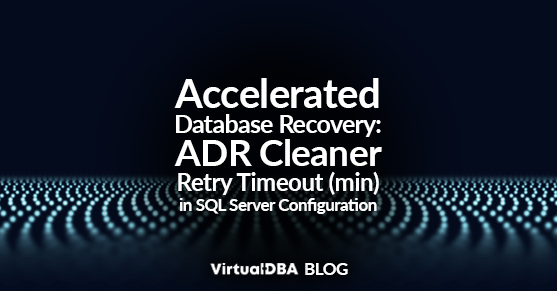What is the ADR Cleaner Retry Timeout (min)?
In SQL Server 2019 and later versions, Accelerated Database Recovery (ADR) employs an asynchronous cleaner process. This process runs periodically to remove unnecessary page versions, streamlining database recovery. However, during these cleanup sweeps, the cleaner might encounter situations where it cannot acquire object-level locks due to conflicts with ongoing user operations.
The ADR cleaner retry timeout (min) setting dictates how long (in minutes) the cleaner will persevere in retrying to acquire these locks before abandoning the cleanup attempt for a specific page. This timeout mechanism helps prevent the cleaner from waiting indefinitely for locks, potentially hindering overall database performance.
Why is this setting necessary?
A well-tuned ADR cleaner retry timeout is essential for maintaining a healthy balance between ADR functionality and user workload. Here’s why:
- Ensuring ADR Efficiency: An appropriate timeout value allows the cleaner to acquire locks and complete cleanup tasks reasonably, optimizing ADR’s effectiveness.
- Preventing Performance Issues: Setting the timeout too high could lead to the cleaner spending excessive time retrying for locks, potentially impacting user queries and slowing down database operations.
- Default Value Considerations: The ADR cleaner retry timeout is set to 120 minutes by default. However, you might need to adjust this value based on your workload characteristics and the desired balance between ADR and user query performance.
Best Practices for Setting the Accelerated Database Recovery Cleaner Retry Timeout (min)
The ADR cleaner retry timeout (min) setting in SQL Server allows you to balance efficient ADR cleanup and smooth user workload performance. Here are some best practices for setting this value:
- Start with the Default: The default value of the ADR cleaner retry timeout is 120 minutes. This is a good starting point for most environments.
- Consider Workload Characteristics: You might need to adjust the timeout if your database experiences frequent lock contention due to high user activity.
- Reduce Timeout for Busy Systems: For heavily used systems with frequent lock conflicts, consider lowering the timeout to a value like 30 or 60 minutes. This prevents the cleaner from holding onto lock acquisition attempts for too long, potentially impacting user queries.
How to Identify if the ADR Cleaner is Stuck
There are a few ways to identify if the ADR Cleaner might be stuck in SQL Server:
1. Analyzing SQL Server logs: Look for error messages related to the ADR cleaner in the SQL Server error log. These messages might include phrases like “Cleanup of sidelist aborted due to timeout” or “ADR cleaner failed to acquire the lock.”
2. Monitoring Lock Wait Statistics: Use queries like sys.dm_os_wait_stats or sys.dm_tran_lock_requests to identify lock wait times related to the ADR cleaner. Excessive wait times for locks held by the cleaner process could indicate it is struggling to acquire locks and might be stuck retrying.
3. Performance Monitoring Tools: Utilize SQL Server performance monitoring tools to track metrics like Lock Waits or ADR Cleaner Queue Length. A significant increase in these values could suggest the cleaner is encountering lock contention and is potentially stuck.
4. Long-Running Cleanup Tasks: Check the SQL Server Management Studio (SSMS) Activity Monitor for long-running tasks related to the ADR cleaner. If you see cleanup tasks taking an unusually long to complete, it might be a sign that the cleaner is stuck.
5. Identifying Slow Database Recovery: If you experience unexpectedly slow database recoveries after a crash or restart, it could indirectly indicate an issue with the ADR cleaner. However, a slow recovery could also have other causes, so investigate further using the abovementioned methods.
Additional Tips
- Correlate the identified symptoms with your ADR cleaner retry timeout setting. If the timeout is very high, it could allow the cleaner to retry for locks that appear stuck for an excessive duration.
- Consider consulting Microsoft documentation or online resources for specific troubleshooting steps related to ADR cleaner issues in your SQL Server version.
By combining these techniques, you can effectively identify potential issues with the ADR cleaner being stuck and take appropriate action to optimize its performance.
Conclusion
The Accelerated Database Recovery ADR cleaner retry timeout (min) is a valuable configuration option for optimizing ADR performance in SQL Server 2019 and beyond. Understanding its purpose and how to set it appropriately empowers you to ensure efficient database recovery without compromising user experience.
For more information, please give us a call!

